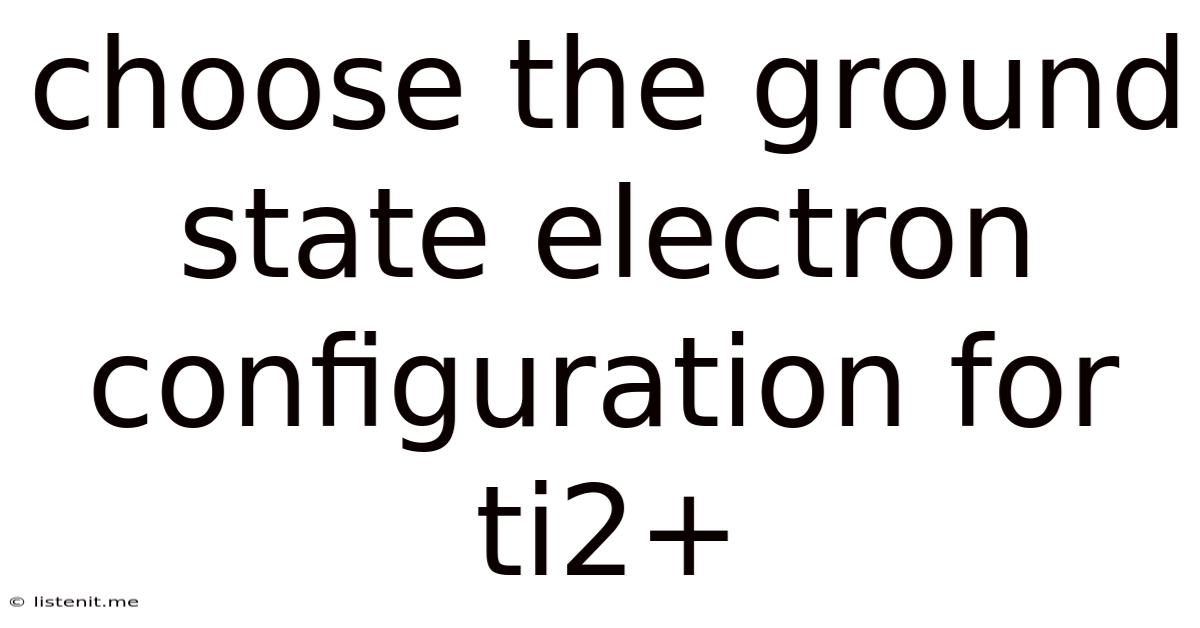Choose The Ground State Electron Configuration For Ti2+
listenit
May 12, 2025 · 4 min read

Table of Contents
Choosing the Ground State Electron Configuration for Ti²⁺: A Deep Dive
Titanium(II) ion, or Ti²⁺, presents a fascinating case study in electron configuration, highlighting the interplay between electron-electron repulsion and the stability afforded by specific orbital arrangements. Determining its ground state electron configuration requires a thorough understanding of several fundamental concepts in chemistry and physics. This article will guide you through the process, exploring the underlying principles and addressing potential misconceptions.
Understanding Electron Configurations
Before delving into the specifics of Ti²⁺, let's review the basics. Electron configuration describes the arrangement of electrons within the orbitals of an atom or ion. This arrangement is governed by the Aufbau principle (filling orbitals from lowest to highest energy), Hund's rule (maximizing unpaired electrons within a subshell), and the Pauli exclusion principle (no two electrons can have the same four quantum numbers).
Key Principles Governing Electron Configuration:
-
Aufbau Principle: Electrons fill orbitals starting with the lowest energy levels. This generally follows the order 1s, 2s, 2p, 3s, 3p, 4s, 3d, 4p, and so on. However, exceptions exist, particularly with transition metals.
-
Hund's Rule: Within a subshell (e.g., 2p, 3d), electrons will individually occupy each orbital before pairing up. This minimizes electron-electron repulsion. Each orbital gets one electron before any orbital gets two.
-
Pauli Exclusion Principle: No two electrons in an atom can have the same set of four quantum numbers (n, l, ml, ms). This means each orbital can hold a maximum of two electrons, with opposite spins.
The Neutral Titanium Atom (Ti)
Neutral titanium (Ti) has an atomic number of 22, meaning it possesses 22 electrons. Its ground state electron configuration is typically written as: 1s²2s²2p⁶3s²3p⁶4s²3d². Note that although the 4s subshell has a lower principal quantum number (n=4) than the 3d subshell (n=3), it is lower in energy, hence filled first. This is a common situation for transition metals.
Ionization and the Formation of Ti²⁺
To form the Ti²⁺ ion, titanium loses two electrons. The question becomes: which two electrons are lost? This is where the nuances of electron configuration become crucial. While the simplistic approach would suggest removing the two 4s electrons, a deeper analysis reveals a more complex picture.
The Role of Effective Nuclear Charge and Shielding
The effective nuclear charge experienced by an electron is the net positive charge it feels from the nucleus, after accounting for the shielding effect of other electrons. Electrons in the 4s subshell are more effectively shielded from the nucleus by the inner electrons than the 3d electrons. Therefore, 4s electrons experience a lower effective nuclear charge and are held less tightly than 3d electrons.
However, the energy difference between the 4s and 3d orbitals is relatively small in transition metals. The process of ionization is not always a simple removal of the highest energy electrons. The removal of the electrons depends on several factors, including shielding, electron-electron repulsion, and exchange energy. These interactions are complex and often cannot be perfectly predicted by simple rules.
Determining the Ground State Electron Configuration of Ti²⁺
Experimental evidence and advanced calculations confirm that the most stable configuration for Ti²⁺ is: [Ar]3d². This means that the two electrons lost are from the 4s orbital.
Therefore, the final answer is [Ar]3d².
While the 4s electrons are often considered higher in energy, the removal of the 3d electrons would lead to higher electron-electron repulsion. Removing the 4s electrons results in a lower overall energy for the ion, making it more stable. The [Ar] core represents the stable electron configuration of Argon.
Why Not Other Configurations?
You might consider other possibilities, but these are less stable. For example, [Ar]4s¹3d¹ is less stable due to Hund's rule (maximizing unpaired electrons within a subshell is energetically favorable). Additionally, a configuration like [Ar]4s² would represent a neutral Ti atom, and not the Ti²⁺ ion.
Practical Applications and Further Exploration
Understanding the electron configuration of ions like Ti²⁺ is crucial in various fields, including:
-
Material Science: Titanium and its compounds exhibit diverse properties depending on oxidation states. Knowing electron configurations helps explain these properties and allows us to design materials with specific characteristics.
-
Catalysis: Titanium compounds act as catalysts in numerous chemical reactions. Understanding their electron configurations aids in designing more efficient and selective catalysts.
-
Spectroscopy: The electron configuration directly affects the energy levels within an ion. Analyzing its spectroscopic properties (e.g., UV-Vis, XPS) reveals the ion's electronic structure.
Conclusion: A Deeper Appreciation for Electron Configuration
Determining the ground state electron configuration of Ti²⁺ involves more than simply applying the Aufbau principle. It necessitates considering the subtle interplay between effective nuclear charge, shielding, electron-electron repulsion, and Hund's rule. This example highlights the complexity and richness of electronic structure, a fundamental concept crucial for comprehending the behavior of atoms and ions. The final, most stable, and experimentally verified configuration is [Ar]3d². This comprehensive analysis demonstrates the importance of understanding the underlying principles to accurately predict and interpret electron configurations. Further exploration of advanced quantum mechanical calculations would offer even deeper insights into these complex atomic interactions. Remember that while rules provide guidelines, experimental evidence and sophisticated calculations are essential for a complete understanding of electronic structure.
Latest Posts
Related Post
Thank you for visiting our website which covers about Choose The Ground State Electron Configuration For Ti2+ . We hope the information provided has been useful to you. Feel free to contact us if you have any questions or need further assistance. See you next time and don't miss to bookmark.